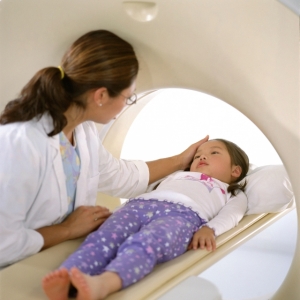by
Joan Trombetti, Writer | February 25, 2009

A young girl being
prepared for a
CT scan
This report originally appeared in the February 2009 issue of DOTmed Business News
In the world of radiology, when using ionizing radiation, children present unique challenges because of their longer life span and higher susceptibility to radiation. Children are more sensitive to radiation and when a doctor orders a CT scan - one size does not fit all. It's logical to assume that if a child takes lower doses of medicine for an illness than does an adult - lower doses of radiation should be administered as well. A CT scan for a child should take into account the child's weight and size to ensure that he or she receives the minimum radiation needed to complete the procedure.
An article published in the New England Journal of Medicine two years ago raised concerns about the use of CT for children, and created issues about the accuracy of the risk models or the degree to which the risks of radiation were emphasized by the authors. According to Dr. Alexander R. Margulis, Clinical Professor of Radiology at Weill Medical College at Cornell University, in his article, "The Last Word," published in Imaging Economics - the radiation doses and CT techniques discussed in the New England Journal of Medicine article for calculating their predictions are higher than the recommendations by the American College of Radiology or the Society of Pediatric Radiology, which are widely accepted and applied. No matter what the disagreements amongst the medical community one fact remains clear -a stronger effort must be made to reduce radiation doses to children undergoing CT scans.



Ad Statistics
Times Displayed: 109208
Times Visited: 6638 MIT labs, experts in Multi-Vendor component level repair of: MRI Coils, RF amplifiers, Gradient Amplifiers Contrast Media Injectors. System repairs, sub-assembly repairs, component level repairs, refurbish/calibrate. info@mitlabsusa.com/+1 (305) 470-8013
Donald Frush, MD,
(Photo courtesy of ACR)
There are many agencies and societies that have been promoting radiation protection for children over the years. These groups such as the Society for Pediatric Radiology, the National Council on Radiation Protection, the American College of Radiology and the US Food and Drug Administration play a major role in spearheading the effort to reduce CT doses nationally, and thereby reduce the theoretical cancer risk in children from CT radiation. More recently, many of these groups have joined forces to speak as a unified voice and add urgency to the call to action.

